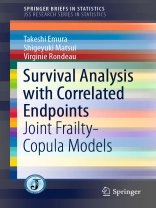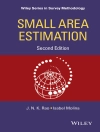This book introduces readers to advanced statistical methods for analyzing survival data involving correlated endpoints. In particular, it describes statistical methods for applying Cox regression to two correlated endpoints by accounting for dependence between the endpoints with the aid of copulas. The practical advantages of employing copula-based models in medical research are explained on the basis of case studies.
In addition, the book focuses on clustered survival data, especially data arising from meta-analysis and multicenter analysis. Consequently, the statistical approaches presented here employ a frailty term for heterogeneity modeling. This brings the joint frailty-copula model, which incorporates a frailty term and a copula, into a statistical model. The book also discusses advanced techniques for dealing with high-dimensional gene expressions and developing personalized dynamic prediction tools under the joint frailty-copula model.
To help readers apply the statistical methods to real-world data, the book provides case studies using the authors’ original R software package (freely available in CRAN). The emphasis is on clinical survival data, involving time-to-tumor progression and overall survival, collected on cancer patients. Hence, the book offers an essential reference guide for medical statisticians and provides researchers with advanced, innovative statistical tools. The book also provides a concise introduction to basic multivariate survival models.
Inhoudsopgave
Chapter 1: Setting the scene.-1.1 Endpoints.- 1.2 Benefits of investigating correlated endpoints.- 1.3 Copulas and frailty: a brief history.- References.- Chapter 2: Introduction to survival analysis .-2.1 Endpoint and censoring.- 2.2 Kaplan-Meier estimator and survival function.- 2.3 Hazard function.- 2.4 Log-rank test for two-sample comparison.- 2.5 Cox regression.- 2.6 Example of Cox regression.- 2.7 Likelihood inference under non-informative censoring.- 2.8 Theoretical notes.- 2.9 Exercises.- References.- Chapter 3: The joint frailty-copula model for correlated endpoints.- 3.1 Introduction.- 3.2 Semi-competing risks data.- 3.3 Joint frailty-copula model.- 3.4 Penalized likelihood with splines.- 3.5 Case study: ovarian cancer data.- 3.6 Technical note 1: Numerical maximization of the penalized likelihood.- 3.7 Technical note 2: LCV and choice of and .- 3.8 Exercises.- References.- Chapter 4: High-dimensional covariates in the joint frailty-copula model.- 4.1 Introduction.- 4.2 Tukey’s compound covariate.- 4.3 Univariate selection.- 4.4 Meta-analytic data with high-dimensional covariates.- 4.5 The joint model with compound covariates .- 4.6 The joint model with ridge or Lasso predictor .- 4.7 Prediction of patient-level survival function .- 4.8 Simulations.- 4.8.1 Simulation design.- 4.8.2 Simulation results.- 4.9 Case study: ovarian cancer data .- 4.9.1 Compound covariate.- 4.9.2 Fitting the joint frailty-copula mode.- 4.9.3 Patient-level survival function.- 4.10 Concluding remarks.- References.- Chapter 5: Dynamic prediction of time-to-death.- 5.1 Accurate prediction of survival.- 5.2 Framework of dynamic prediction.- 5.2.1 Conditional failure function given tumour progression.- 5.2.2 Conditional hazard function given tumour progression.- 5.3 Prediction formulas under the joint frailty-copula model.- 5.4 Estimating prediction formulas.- 5.5 Case study: ovarian cancer data.- 5.6 Discussions.- References.- Chapter 6: Future developments- 6.1 Analysis of recurrent events.- 6.2 Kendall’s tau in meta-analysis.- 6.3 Validation of surrogate endpoints.- 6.4 Left-truncation.- 6.5 Interactions.- 6.6 Parametric failure time models.- 6.7 Compound covariate.- References.- Appendix A: Cubic spline bases.- Appendix B: R codes for the ovarian cancer data analysis.- B1. Using CXCL12 gene as a covariate.- B2. Using compound covariates (CCs) and residual tumour as covariates.- Appendix C: Derivation of prediction formulas.
Over de auteur
Takeshi Emura, Chang Gung University
Shigeyuki Matsui, Department of Biostatistics, Nagoya University Graduate School of Medicine
Virginie Rondeau, INSERM U 1219












